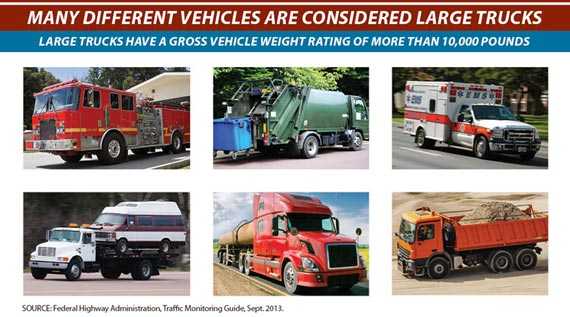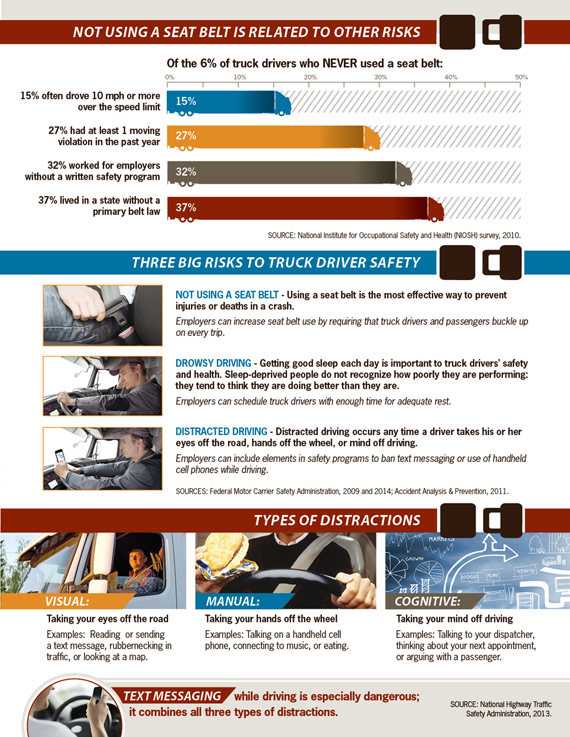Trucker Safety
Using a seat belt matters
March 2015


 317,000
317,000
An estimated 317,000 motor vehicle crashes involving a large truck were reported to the police in the US in 2012.
 26,000
26,000
26,000 truck drivers or their passengers were injured in crashes in 2012.
 700
700
About 700 truck drivers or their passengers died in crashes in 2012. Buckling up could have saved up to 40% of the unbelted truck drivers.
Trucker safety requires an alert, buckled-up, experienced driver, with a reliable vehicle and strong employer safety programs. About 2.6 million workers drive trucks that weigh over 10,000 pounds (large trucks). About 65% of on-the-job deaths of US truck drivers in 2012 were the result of a motor vehicle crash. More than 1 in 3 truck drivers have had a serious truck crash during their career, and 1 in 8 has had 2 or more. Buckling up is both effective and required by federal regulations. But 1 in 6 drivers of large trucks don't use their seat belts (2013). More than 1 in 3 truck drivers who died in crashes in 2012 were not wearing seat belts. Buckling up could have prevented up to 40% of these deaths.
Employers can help truck drivers stay safe by:
- Committing to driver safety programs at the highest level of leadership.
- Establishing and enforcing driver safety policies, including requiring everyone in the truck to buckle up.
- Involving workers in decisions about how to put seat belt programs in place.
- Promoting seat belt use in training and safety meetings.
- Addressing factors that contribute to crashes, such as drowsy and distracted driving, in their driver safety programs.
Problem
Crashes are the leading cause of on-the-job deaths for truck drivers in the US.
About 65% of on-the-job deaths of truck drivers are due to motor vehicle crashes.
- A total of 697 drivers of large trucks or their passengers died in crashes in 2012.
- Deaths of drivers and passengers in large trucks increased between 2009 and 2012, after dropping to 35-year lows in 2009.
- For each driver or passenger in a large truck who died, about 6 other people (people in other vehicles, pedestrians, or cyclists) died as a result of large-truck crashes in 2012.
- Fatal crashes of large trucks and buses cost the US economy about $40 billion in 2012. The total cost – $99 billion – is much higher when crashes with injuries or property damage are also included.
Thousands of truck drivers are injured in crashes every year.
- About 26,000 large-truck drivers or their passengers were injured in 2012.
- For each large-truck driver who died, 35 were injured.
- About 41% of truck drivers who lost work days from a crash in 2012 missed 31 days or more.
Many truck drivers do not use a seat belt on every trip, which increases risk of injury and death.
- In research studies, about 1 in 6 of US large truck and bus drivers was observed not wearing a seat belt in 2013.
- About 14% of long-haul truck drivers (who deliver in several states and sleep at home only a few nights a month) reported not using a seat belt on every trip (6% never, and 8% sometimes), according to a 2010 study.
- Observed seat belt use for drivers of large trucks and buses increased as more states added primary enforcement seat belt laws that allow a police officer to pull over and ticket a driver or passenger for not wearing a seat belt, even if this is the only violation the officer sees (48% in 2003 to 84% in 2013).
Infographic
What Can Be Done
Federal government is
- Requiring drivers of large trucks to wear seat belts.
- Limiting the number of hours a truck driver can drive and be on duty in a day.
- Requiring truck drivers to take rest breaks.
- Prohibiting truck drivers from text messaging or using a handheld cell phone while driving a truck.
- Working to improve trucking safety through the "Compliance, Safety, Accountability" program.
State officials can
- Increase seat belt use through primary enforcement seat belt laws that allow a police officer to pull over and ticket a driver or passenger for not wearing a seat belt, even if this is the only violation the officer sees.
- Work with employers to increase truck driver education on seat belt use.
- Include information in driver education manuals and classes on how cars and other vehicles can be driven safely around large trucks.
Law enforcement can
- Promote truck driver safety by enforcing laws on seat belt use, maximum hours of driving, text messaging, use of handheld cell phones, and speed limits.
- Coordinate enforcement measures with state motor carrier safety inspectors that relate to maximum hours of driving, seat belt use, cargo securement, text messaging, use of handheld cell phones, weight limits, and other driver or vehicle safety matters.
Employers can
- Establish and enforce company safety policies, including seat belt use requirements for truck drivers and passengers, as well as bans on text messaging and use of handheld cell phones.
- Educate drivers on seat belt use and ways to avoid drowsy or distracted driving.
- Work with dispatchers, shippers, and receivers to set delivery schedules that do not require drivers to break speed limits or regulations for maximum hours of driving.
Truck drivers can
- Wear their seat belts every time, every trip.
- Insist that their passengers also wear their seat belts.
- Follow regulations that prohibit truck drivers from text messaging or using a handheld cell phone while driving a truck.
- Learn how to avoid drowsy and distracted driving in order to protect themselves and others.
Science Behind the Issue
Related Pages
- Vital Signs Issue details: Seat Belt Use Among Long-Haul Truck Drivers — United States, 2010, Morbidity and Mortality Weekly Report (MMWR)
- Vital Signs – Trucker Safety [PODCAST – 1:15 minutes]
- Vital Signs – Trucker Safety [PSA – 0:60 seconds]
- NIOSH Center for Motor Vehicle Safety
- Trucking Safety
- Long-haul Truck Drivers
- Transportation, Warehousing and Utilities
- Work Schedules: Shift Work and Long Work Hours
On Other Web Sites
- MedlinePlus – Motor Vehicle Safety
- MedlinePlus – Occupational Health
- Federal Motor Carrier Safety Administration (FMCSA)
- Large Truck and Bus Crash Facts 2012
- Federal Trucking Regulations
- National Highway Traffic Safety Administration
- Insurance Institute for Highway Safety: State laws and regulations
- North American Fatigue Management Program
- Page last reviewed: March 3, 2015
- Page last updated: March 3, 2015
- Content source:
- National Institute for Occupational Safety and Health, Center for Motor Vehicle Safety
- Page maintained by: Office of the Associate Director for Communications (OADC)


 ShareCompartir
ShareCompartir

